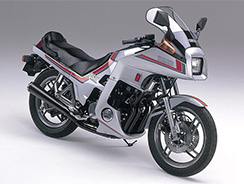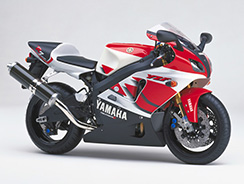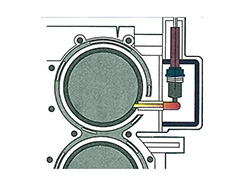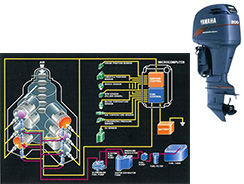Electronically-Controlled Fuel Injection
介绍雅马哈发动机技术背后的故事。

Yamaha’s first step into the field of fuel injection was the system mounted on the 1982 XJ750D (#1). Data on engine rpm, intake air volume, engine temperature, ignition timing, etc., was processed by a microcomputer to calculate optimum fuel injection volume based on the running conditions of the engine. This achieved sharper response, greater fuel efficiency and better engine starts. Then, with the GTS1000 sport-tourer model released in 1993, Yamaha supplemented the fuel injection control system with oxygen (O2) feedback control*1 and a 3-way catalytic converter to achieve cleaner emissions along with better fuel economy and running performance. The merits of the fuel injection system were also employed on the high-performance race-focused YZF-R7 in 1999 (#2), and then on more big-displacement models like the FJR1300 and the YZF-R1 for a strong combination of both machine performance and environmental friendliness.
One of the big advances in fuel injection systems for motorcycles can be seen in the one developed for the Taiwan-spec Majesty 125FI released in 2002 (#3). At the time, the fuel injection systems on the FJR1300 and the YZF-R1 were using a large variety of sensors and had become quite complex. Instead, the system for the Majesty 125FI was developed with every effort to simplify it as much as possible. Taking advantage of the fact that the changes in pressure in the air intake ducts were closely related to ambient air pressure and throttle opening, Yamaha engineers developed a system that used a single sensor as a source for multiple information parameters, reducing the number of sensors needed in half. Also, creating a modular (integrated) design for some of the fuel delivery components made the system lighter and more compact. This fuel injection system later became Yamaha’s standard format for small motorcycles and was further developed over time. More recently, the latest version of this compact fuel injection system was worked into the “BLUE CORE” engine for the 2014 Grande 125cc scooter for ASEAN markets.
Fuel Injection for Marine Engines
Fuel injection systems contribute greatly to the performance and eco-friendliness of marine engines as well. The 2-stroke V6 OX66-based*2 engines (150–250 hp) introduced in 1996 were the first Yamaha marine engines with an electronically-controlled fuel injection system. They were built by Sanshin Industries Co., Ltd.*3 and destined for the U.S. market initially. The OX66 was the first Yamaha 2-stroke outboard engine with a fuel injection system, and it was also fitted with the world’s first practical oxygen sensor for a 2-stroke engine. Unlike 4-stroke automobile or motorcycle engines where the oxygen sensor is positioned in the exhaust pipe, the sensor for these 2-stroke outboards was fitted to a resonator chamber next to the cylinder (#4) to protect it from saltwater backwash. This innovative Yamaha air-fuel ratio feedback control system heightened the precision of the electronically-controlled fuel injection system and achieved high performance as well as good fuel efficiency.
Another revolutionary advancement was the High Pressure Direct Injection (HPDI) system mounted on the Z200N 2-stroke V6 outboard motor released in 1999. This was the world’s first electronically-controlled fuel injection system for high-pressure, airless direct-injection for a 2-stroke engine (#5). Injecting the fuel at a pressure of 50–70 atmospheres (734–1,028 psi) atomizes the fuel droplets to just a few tens of microns. This promotes much finer atomization than conventional systems in which the fuel is injected into the intake passage, enabling highly efficient combustion with a leaner fuel charge. Because the injection is timed to coincide with the complete closing of the exhaust port, there is virtually none of the “blowback” that is a common drawback of 2-stroke engines, and this in turn brings great improvements in both fuel efficiency and exhaust emissions. In this way, Yamaha’s electronically-controlled fuel injection systems have continued to evolve in answer to customer needs.
*1:氧传感器检测排气中残留的氧浓度,从而能够估计燃烧条件。然后使用该信息以电子方式控制和优化燃料输送(空燃比)。其结果是提高了功率输出、更少的燃料消耗、更清洁的排放以及更好的废气催化。
*2:OX66中的“O”代表“氧传感器”,“X”代表V型发动机。两个 6 表示六个气缸中的每一个都有自己的喷油器。
*3:三信工业(株)Co., Ltd. 成立于 1960 年,是雅马哈发动机的船用发动机制造子公司。其主要业务是雅马哈品牌舷外发动机和其他发动机的开发和制造。 2003年公司更名为雅马哈船舶株式会社,2008年与雅马哈发动机株式会社




